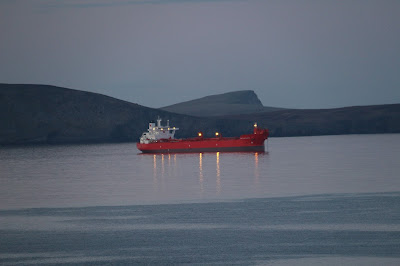 |
| A relatively early morning dash to the ferry port for Whalsay, Laxo, was to no avail. When we got there, we were greeted with the news that the ferry wasn't running due to an electrical problem. A mechanic was on the way but there was no guarantee of a reasonably prompt departure. As there was absolutely nothing at Laxo apart from the landing pier, we turned to Plan B. |
 |
| Plan B was a circular walk along the Northmavine coast from Eshaness lighthouse. It was around 5 miles, there and back in rather nice weather as the photographs below will show. |
 |
| The dramatic coastline looking northwards from the lighthouse. The next landfall from this spot would be Greenland, which is not visible even through the conditions were very clear. |
 |
| Another cliffscape. This time looking back down the coast towards the lighthouse. Look at the blue sky! |
 |
| We did this walk the last time we visited Shetland (in 2013). Then, the weather conditions were different, with waves crashing over the cliffs in the distance. |
 |
| Mrs P x 2 and Mrs S, looking out to sea or were they facing inland? I really can't remember. |
 |
| Close to Eshaness is the Cross Kirk graveyard and this rather intriguing plaque that duplicates the faded inscription on the grave below. It tells the tale of Donald Robertson, who became famous for being unfortunate. He died because Laurence Tulloch, a pharmacist in Sullom, gave him Salpeter (used as fertiliser and for making fireworks) instead of Epsom salt, a natural remedy for all kinds of ailments. Donald Robertson suffered a painful death because his blood was no more able to carry the oxygen his body needed.In a trial in Lerwick, Tulloch was accused of culpable homicide. He was found guilty but the jury appealed to the sheriff. They thought it was nothing but a terrible accident. Tulloch was incarcerated for a few days and walked scotfree. He and his family, his wife Agnes and his two daughters, left Shetland after a while. He must have felt unable to live in that small community any longer. Did people ostracize him for his “error”? Or did they believe worse? Did some think he had done it on purpose? Officially it remains a tragic accident and the stone in the graveyard won’t reveal more. But the graveyard gives you all the space you need to ponder on the fate of Donald Robertson. |
 |
| Of the many geese that pass through Shetland as they migrate, the only type we saw was the largest, the Greylag Goose. Their honking skeins flew over our chalet every night and morning |
 |
| The Lapwing is also known as the Green Plover. This shot clearly shows why. It's also known as a Peewit, which is a not-too-bad rendition of its call. |
 |
| A solitary fishing boat heading out to sea from Scalloway with the evening sun lighting up the houses in the background. Once upon a time, Scalloway was the capitol of Shetland. |






No comments:
Post a Comment